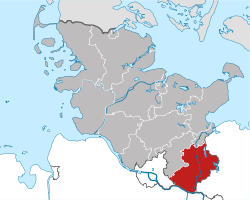Herzogtum Lauenburg
| Herzogtum Lauenburg | ||
|---|---|---|
| District | ||
|
||
 |
||
| Country |
|
|
| State | Schleswig-Holstein | |
| Capital | Ratzeburg | |
| Area | ||
| • Total | 1,263 km2 (488 sq mi) | |
| Population (31 December 2015) | ||
| • Total | 192,999 | |
| • Density | 150/km2 (400/sq mi) | |
| Time zone | CET (UTC+1) | |
| • Summer (DST) | CEST (UTC+2) | |
| Vehicle registration | RZ | |
| Website | herzogtum-lauenburg.de | |
Herzogtum Lauenburg (English: Duchy of Lauenburg) is the southernmost Kreis, or district, of Schleswig-Holstein, Germany. It is bordered by (from the west and clockwise) the district of Stormarn, the city of Lübeck, the state of Mecklenburg-Vorpommern (districts of Nordwestmecklenburg and Ludwigslust-Parchim), the state of Lower Saxony (districts of Lüneburg and Harburg), and the city state of Hamburg. The district of Herzogtum Lauenburg is named after the former Duchy of Saxe-Lauenburg.
The district's territory comprises most of the former Duchy's territory north of the river Elbe, except of the Amt Neuhaus. All the former Saxe-Lauenburgian areas beyond the Elbe belong today to the Lower Saxon districts of Cuxhaven (Land of Hadeln), Harburg and Lüneburg.
The district's area contains a number of historically important towns, e.g. Lauenburg/Elbe, Mölln and Ratzeburg. This importance was due to the Old Salt Route (Alte Salzstraße), one of the major medieval trade routes. Salt from the salt-works south of the Elbe river was transported northward to Lübeck. The transport of salt was also the motive for constructing the oldest artificial waterway of Europe, the Stecknitz Canal (1398). It was replaced in 1900 by the Elbe-Lübeck Canal.
...
Wikipedia

